
As the global economic landscape shifts, all eyes are turning to India as a potential powerhouse of the next big manufacturing wave. With geopolitical realignments pushing companies to diversify supply chains and governments emphasizing self-reliance, India is presented with a timely opportunity to position itself as a global manufacturing hub. But the question remains: Is the country truly ready to seize this moment?
Over the last few years, India has made substantial progress in creating a business-friendly environment. Structural reforms such as the introduction of the Goods and Services Tax (GST), digitization of compliance processes, and improved ease of doing business rankings have laid a strong foundation. More recently, targeted schemes like the Production Linked Incentive (PLI) program have injected fresh momentum into key sectors such as electronics, pharmaceuticals, and auto components. These policies are designed not only to attract foreign investment but also to bolster domestic capacities.
Infrastructure development, long considered a bottleneck, is also being addressed with renewed urgency. The expansion of industrial corridors, improvements in logistics, and focus on multi-modal connectivity through initiatives like PM Gati Shakti are gradually reshaping India’s physical and digital infrastructure. The push for renewable energy and sustainable practices further strengthens India’s appeal to global manufacturers looking to align with ESG mandates.
However, challenges persist. The availability of skilled labor, bureaucratic delays at the state level, and inconsistent implementation of reforms still pose hurdles. Moreover, while the PLI schemes are promising, their long-term impact depends on consistent policy support and on-ground execution.
Another critical area is innovation and R&D. For India to lead the next phase of global manufacturing, it must go beyond being a low-cost alternative and move towards becoming a value-added production center. This requires significant investment in research, skilling, and technology adoption.
Despite these hurdles, the momentum is unmistakable. India’s large consumer base, democratic framework, and growing middle class offer an added advantage—domestic demand can complement exports, creating a self-sustaining manufacturing ecosystem.
In essence, while the path is not without obstacles, India stands at the threshold of a manufacturing transformation. The intent is clear, the direction is promising, and with sustained execution, the country has every chance of not just participating in but leading the next global manufacturing boom.


